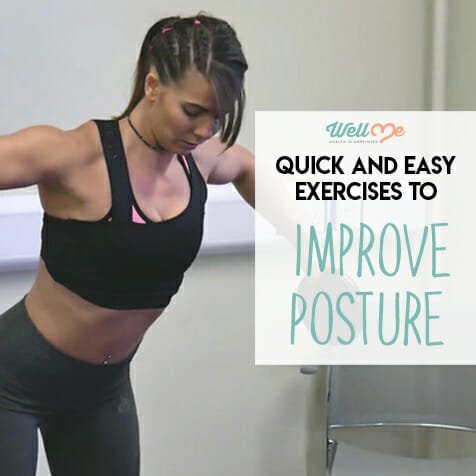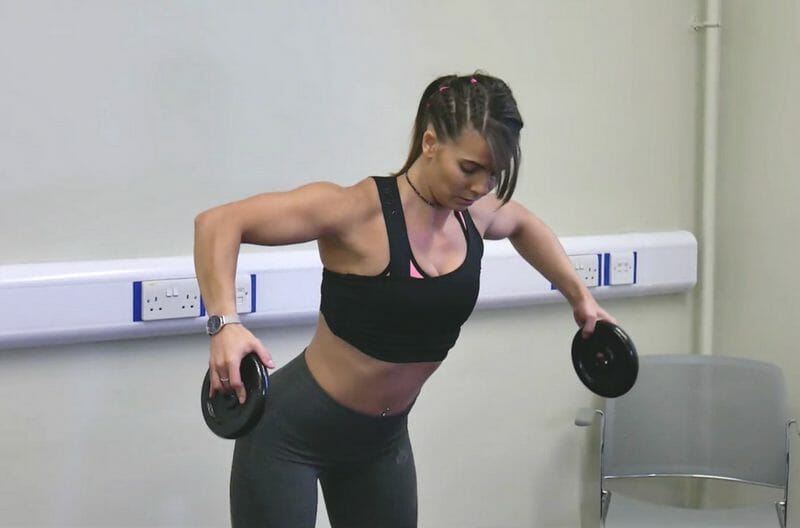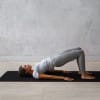7 Most Easy Steps to Improve Posture!
When you’re a kid, did your mother ever tell you to”sit up straight?” You probably have tired of hearing it after a while, but now that you’re an adult, you might be wishing you’d listened. Poor posture is a frequent problem, but a lot of people fail to understand exactly how serious a problem it really is. Luckily for most people, this can be remedied by doing some basic exercises to improve posture.
Bad posture can be the consequence of bad habits like slouching or hunching over the computer keyboard. But, it may also be a sign of more serious issues like muscle weakness, poor core stability, joint problems, or muscle guarding related to bodily injury. If you have had poor posture for any duration of time, the odds are good that you’ve also experienced some of the painful side effects. Step one is to speak with your doctor to identify the root cause of your position problems. From that point, you can consider extra therapies and begin doing some exercises to improve posture.
Oftentimes, poor posture is something that may be adjusted through posture exercises. Keep reading to find out more about the source of terrible posture and how to correct posture with seven easy posture correction exercises.
Page Contents…
- 1 What Causes Poor Posture?
- 2 What Are the Best Exercises to Improve Posture?
- 3 How to Correct Posture Problems Through Exercise and Good Habits
- 4 References
What Causes Poor Posture?

Bad posture is also known as postural dysfunction. It occurs when the spine is positioned in an unnatural way and can add excess stress on the joints, muscles, and vertebrae. So, what exactly does poor posture look like? First, let’s take a quick look at the hallmarks of good posture:
- Balanced, upright carriage
- Straight line from ear to shoulder to hip
- No rounding of the shoulders
Now, let’s take a look at some of the signs of bad posture:
- Rounded shoulders (hunched back)
- Potbelly (lower belly pooch)
- Head leans slightly forward or backward
- Bent knees when standing or walking
There are varying degrees of bad posture, but many people who have it experience some negative effects associated with it. The most common side effects of poor posture include:
- Back pain
- Neck pain
- Body aches and pains
- Stiffness
- Muscle fatigue
- Headaches
Did you know that wearing high heeled shoes is bad for your posture and could lead to lower back problems?
In most cases, bad posture develops over time as a result of bad habits. It can also be related to occupational demands, sedentary lifestyles, physical injury, and poor ergonomic work environment. It only makes sense, then, that correcting some of these habits is how to correct posture problems. Here are some of the bad habits that contribute to poor posture:
- Slouching
- Sticking your bottom out
- Standing with a flat back
- Leaning on one leg
- Hunching over
- Cradling a phone
- Rounding your shoulders
If you are guilty of any of the above, don’t panic! Fortunately, these habits are things that can be corrected. It may take time to improve your posture but changing your habits and learning some posture correction exercises can help. Keep reading to learn how to correct posture with seven easy exercises.
What Are the Best Exercises to Improve Posture?
Whether you’re a regular gym-goer or not, it is important to put some effort into functional fitness. There are certain exercises you can practice to improve your fitness for performing everyday tasks such as lifting heavy things. In a similar way, you can also do exercises to improve posture. Here are seven posture exercises you can try at home:
1. Plank | 30 secs
You may not think about it this way, but a strong core is actually the basis for great posture. Determined which version of this plank you are doing, you could also engage your other major muscles such as your spine, arms, shoulders, glutes, and legs. To perform a classic plank, get down on all fours with your hands directly under your shoulders, balancing on your feet. Hold this position for at least 30 seconds.
Once you’ve perfected the traditional plank, you can try a few of the variants — this will allow you to add some interest to your workout routine whilst at the same time working your abs from different angles. You may not think of your abs as an important part of posture correction exercises, but you should really be engaging your abs during any kind of workout.
- Forearm plank – begin in classic plank position. Lower yourself onto your forearms, bending the elbows at a right angle, so they are positioned directly beneath your shoulders.
- One-legged plank – start in a classic plank position. Then, lift and hold one leg, alternating sides. To make it more difficult, lift one leg and lift the opposite arm at the same time.
2. Swimmers | 7 reps
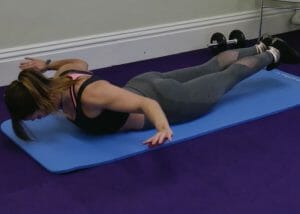
While you’re down on the yoga mat, try these posture correction exercises. Flip over onto your stomach with your arms and legs extended. Keeping your arms straight out in front of you, lift your upper body a few inches off the mat, keeping your head in a neutral position. Swing your arms out to the sides in a swimming motion until your hands are on either side of your hips. Raise your arms up and over your head, keeping your shoulders relaxed. Then, lower your back down until your palms touch the mat. Repeat for seven repetitions then perform another two sets.
3. Scarecrow | 4 reps
Grab a pair of light dumbbells and stand with your feet about hip-width apart. Bend your knees just slightly then hinge forward at the waist to about 45 degrees, preserving the natural curve of your spine. Begin with your arms hanging down in front of you. Then pull your shoulder blades together, bending at the elbow to bring the weights up to either side. When your elbows form a 90-degree angle, rotate your hands up until they are parallel with your spine. Next, straighten your arms to press the dumbbells over your head, keeping that straight line. Reverse the steps to return to the starting position then repeat for three sets of four repetitions.
4. Dumbbell Side Bends | 5 reps
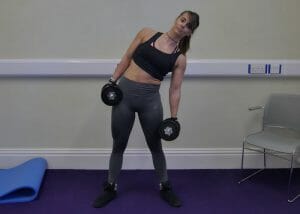
While you’re holding the dumbbells, stand upright but widen your stance to a little more than shoulder-width. Relax your arms down to either side, palms facing in. Then slowly bend to the right, moving your upper body as one unit. When you start to feel a pull in the side of your abdominal muscles, return to the original stance then repeat on the other side. Perform three sets of five repetitions.
5. Shoulder Rotations | 8 reps
Standing upright with your feet hip-width apart, grab a pair of light dumbbells. Bend your elbows to 90 degrees, your forearms parallel to the ground in front of you, palms facing up. Keeping your elbows tucked to your torso, rotate your arms out to the sides while maintaining that 90-degree bend. Keep rotating until you feel your shoulder blades come together and your chest muscles stretch. Slowly bring your hands back together then repeat for three sets of eight reps.
6. Dumbbell Halos | 5 reps
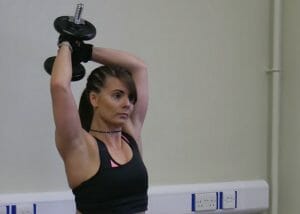
Put down one of the dumbbells and hold the other with both hands, standing with your feet hip-width apart. Pull the dumbbell in toward your chest, bending the elbows while keeping them tucked to your sides. Bring your left hand across your chest then circle it around your head, moving the dumbbell in a circle or “halo” around your head. Try to keep your shoulder blades pulled back, your back straight with a neutral spine, and your head stationary. Repeat for ten rotations in one direction then do ten in the other direction. Complete three sets of five reps each way.
7. Spine Openers | 7 reps
Sit down on a bench or stool – a chair with a short back may work, but you need to be able to bend freely backward. Place your hands behind your head at the base of your neck then engage your core and move with your upper back. Lift your chest and elbows toward the ceiling, trying not to arch your lower back. Lean until you feel a stretch in your abdominal muscles then return to the starting position and repeat for three sets of seven reps.
How to Correct Posture Problems Through Exercise and Good Habits
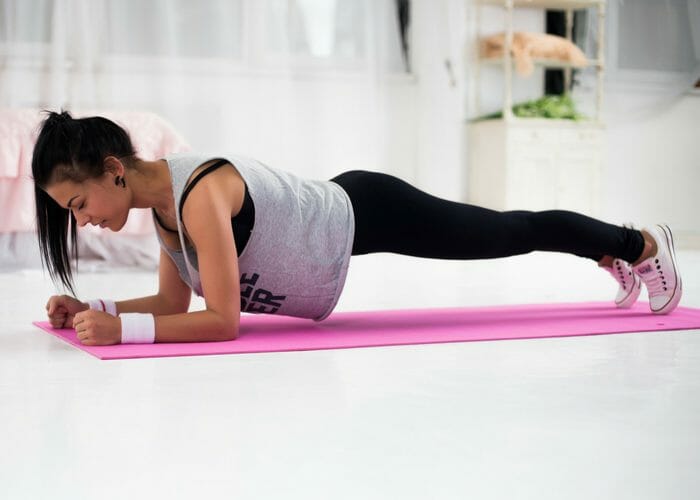
These seven exercises to improve posture are specifically designed to stretch and strengthen the muscles in your core, shoulders, and back, all of which play a role in your posture. The more frequently you perform these posture exercises, the faster you’ll see progress. Keep in mind that you must also correct any bad habits you may have developed which contributed to your poor posture in the first place.
To maintain your benefits, make sure to sit correctly with your back against your chair and your feet planted firmly on the floor. If you work at a computer, make sure your eyes are level with the center of your monitor. If they aren’t, raise or lower your monitor accordingly. Throughout the workday, make an effort to check your posture at least once an hour. If you find that you’re slipping back into bad habits, take a quick break to stand up and stretch out. Do some neck rolls and shoulder raises to work out any sore or stiff muscles then get back to the grind.
By cultivating good habits and practicing posture correction exercises, you’ll be on your way to getting rid of that slouch for good!
